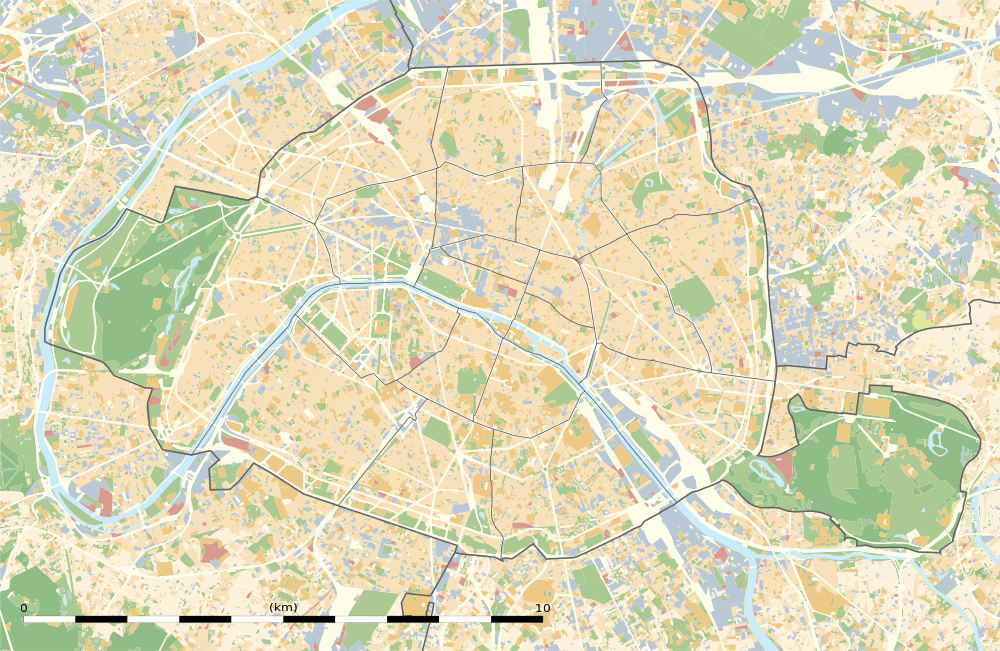Paris architecture in the era of absolutism
The architecture of Paris and its nearest surrounding suburbs in the era of absolutism (16–18th centuries)[lower-alpha 1] went through several important historical stages: the transition from Flamboyant to the Renaissance, the emergence of the "Jesuit style" and mannerism, the birth of Baroque and Classicism, the rise of the decorative Rococo style. The Italian wars had a great influence on Parisian architecture and urban planning, during which the court of Louis XII became acquainted with the ideas of the Italian Renaissance.

Invited Italian architects began to turn the medieval castles of French kings and court nobles into elegant palace residences with representative facades and richly decorated halls. It was under Francis I, who waged protracted wars with the Habsburgs for hegemony in the Mediterranea, that the French Renaissance flourished.
The transformation of the Louvre into a royal palace was associated with the further development of Renaissance architecture in France, which dominated the entire 16th and early 17th centuries. During this time, under the influence of various factors, Parisian architecture underwent significant changes, which affected the development and appearance of the capital. The construction of the Luxembourg Palace in the first third of the 17th century ended the era of the French Renaissance in Paris, and the end of the colonnade of the eastern facade of the Louvre in the second half of the 17th century marked the formation of the classicist style.
After the sunset of the Renaissance in Paris, classicism for a long time coexisted with another stylistic trend - Baroque. The construction of Les Invalides at the end of the 17th century completed the monumental Baroque style, which in the first quarter of the 18th century actually turned into decoration of the mansions and palaces of the Paris aristocracy (this style of interiors was called Rococo). At the same time, classicism reigned supreme in the architecture of the city throughout the eighteenth century (its sign was Église Sainte-Geneviève, and the most grandiose urban ensemble was the Place Louis XV at the tip of the Tuileries Garden).
The architecture of the interiors of the absolutism era was most clearly expressed in the royal palaces of Paris - the Louvre, the Tuileries, the Palais Royal and Luxembourg, as well as in the suburban residences of the kings - Versailles, Grand and Small Trianon, Marly, Saint Germain, Saint-Cloud, Medon, Boulogne, Muette, Vincennes, Choisy-le-Roi, Rambouillet and Fontainebleau.
In the architecture of Paris of the era of absolutism, one can trace the evolution of urban compositions (palace and park ensembles and squares) from the early Renaissance to the heyday of classicism (with elements of an emerging Empire style) and Baroque. The era of absolutism ended with the Great French Revolution and the overthrow of Louis XVI. During the revolution, the symbol of tyranny was demolished - the medieval fortress-prison of the Bastille, on the site of which today is the Place de la Bastille. In addition, the revolutionary element removed royal statues from the metropolitan areas, partially destroyed or converted some churches and tax outposts.
Historical background
By the beginning of the Renaissance, medieval Paris was a controversial sight. The city had outstanding works of Romanesque and Gothic architecture, however, Parisian buildings were dominated not by stone temples and palaces, but by wooden residential buildings that crowded along narrow and winding streets with open gutters. On both sides of the bridges across the Seine were benches with workshops and living quarters of the owners. New waves of visitors sought to settle within the old fortress walls, so the streets and courtyards were given a minimum of space. By the end of the 15th - beginning of the 16th centuries, more than 300 thousand citizens lived in Paris; it was one of the largest cities in Europe. Often Paris of that era was called the "urban colossus in an agricultural country".[2]
In the XVI century, Paris entered a new phase for itself, associated with the gradual strengthening of absolute monarchy, the expansion of feudalism and the emergence of capitalism, which radically influenced the architecture and urban planning of the capital. Over three centuries, the architecture of the city has undergone significant changes and went through several stylistic stages. All this happened against the backdrop of the growing social role of the merchants, the separation from the feudal estate of the urban bourgeoisie and the elimination of the feudal fragmentation of France. During the unsuccessful for France Italian Wars, the French aristocracy became closely acquainted with Italy, where at that time a new worldview and Renaissance art were rapidly developing. French kings drew attention to secular nature and humanism of Italian art. The increased wealth and desire to emphasize the greatness of the royal court prompted the monarchs to begin large-scale palace construction on the basis of principles borrowed from the architecture of the Italian Renaissance. Louis XII and his son-in-law Francis I began to actively invite architects and artists from Italy to rebuild their heavy castles.[3][4][5]
In the second half of the 16th century, the protracted Religious Wars between Catholics and Protestants, whose apotheosis in Paris became St. Bartholomew's Day massacre, as well as the peasant wars of the 1590s led to the devastation of the treasury and reduced funding for the new construction. Economic difficulties, in turn, led to a simplification of architecture. Even in relatively prosperous Paris, they began to build mainly of brick, only occasionally using stone, and reduced the use of decorative details to a minimum. This desire for minimalism in architecture found an echo in one of the first Parisian ensembles - Place des Vosges.[1]

2. Tuileries Palace
3. Palais-Royal
4. Saint-Germain l'Auxerrois
5. Saint-Roch
6. Place Vendôme
7. Fontaine des Innocents
8. Saint-Eustache
9. Place des Victoires
10. Hôtel de Ville
11. Saint-Gervais-Saint-Protais
12. Saint-Paul-Saint-Louis
13. Musée Carnavalet
14. Institut de France
15. Place Dauphine
16. Saint-Germain-des-Prés
17. Odéon-Théâtre de l'Europe
18. Luxembourg Palace
19. Sorbonne Chapel
20. Hôtel Salé
References
Notes
Citations
- Ayers 2004, p. 11.
- Ayers 2004, p. 10.
- Ayers 2004, p. 10-11.
- Moffett, Fazio & Wodehouse 2003, p. 341.
- Baridon 2008, p. 9.
Bibliography
- Marie-Rose Albrecht, Marguerite Cécile Albrecht (1987). David d'Angers: regards autour d'un sculpteur (Том 1). Hérault.
- Ayers, Andrew (2004). The Architecture of Paris: An Architectural Guide. Stuttgart/London: Edition Axel Menges. ISBN 3-930698-96-X.
- Joanna Banham (2015). Encyclopedia of Interior Design. New York: Routledge. ISBN 978-1-884964-19-0.
- Calixte Baniafouna (2009). Les Noirs de l'Elysée: Un palais pas comme les autres. Paris: Editions L'Harmattan. ISBN 978-2-296-11269-8.
- Baridon, Michel (2008). A History of the Gardens of Versailles. Philadelphia: University of Pennsylvania Press. ISBN 978-0-8122-4078-8.
- Jules Léonard Belin, A. Pujol (1845). Histoire civile, morale et monumentale de Paris depuis les temps les plus reculés jusqu'à nos jours. Paris: Belin-Leprieur.
- Anthony Blunt (1980). Art and architecture in France, 1500 to 1700. Penguin Books. ISBN 9780140561043.
- Cyril Bordier (1998). Louis Le Vau: Les immeubles et hôtels particuliers parisiens. L. Laget.
- G. Byrne Bracken (2011). Walking Tour Paris: Sketches of the city’s architectural treasures. Journey Through Paris' Urban Landscapes. London: Marshall Cavendish. ISBN 978-981-4435-37-6.
- Allan Braham (1989). The Architecture of the French Enlightenment. University of California Press. ISBN 9780520067394.
- Pierre Casselle, Françoise Masson (1998). L'Hôtel de ville de Paris. Paris: Imprimerie Nationale.
- Gilles Desmons (2008). Walking Paris. London: New Holland Publishers. ISBN 978-1-84773-061-9.
- Henry Sutherland Edwards (2014). Old and New Paris: Its History, its People and its Places (Volume II). Lulu Press. ISBN 978-1-312-00503-7.
- André Gabriel (1998). Guide to the architecture of monuments in Paris. Éditions Alternatives. ISBN 9782862271484.
- Anthony Gerbino (2012). François Blondel: Architecture, Erudition, and the Scientific Revolution. London: Routledge. ISBN 978-0-415-49199-0.
- David A. Hanser (2006). Architecture of France. London: Greenwood Publishing Group. ISBN 0-313-31902-2.
- Colum Hourihane (2012). The Grove Encyclopedia of Medieval Art and Architecture (Том 2). New York: Oxford University Press. ISBN 978-0-19-539536-5.
- Robert Colonna d`Istria (2002). Paris and Versailles. Paris: Editions Marcus. ISBN 2-7131-0202-2.
- Edouard Leduc (2013). Dictionnaire du Panthéon (de Paris). Paris: Editions Publibook. ISBN 9782342015508.
- Gilles Marchand (2003). Dictionnaire des monuments de Paris. Paris: Editions Jean-Paul Gisserot. ISBN 9782877477222.
- James L. McClain, John M. Merriman, Kaoru Ugawa (1997). Edo and Paris: Urban Life and the State in the Early Modern Era. Ithaca, New York: Cornell University Press. ISBN 978-0-80-148183-3.CS1 maint: multiple names: authors list (link)
- Michele Melaragno (2012). An Introduction to Shell Structures: The Art and Science of Vaulting. New York: Springer Science & Business Media. ISBN 9781475702231.
- Eugène Ménorval (1872). Les Jésuites de la rue Saint Antoine, l'église Saint-Paul-Saint Louis et le lycée Charlemagne: notice historique. Paris: Auguste Aubry.
- Marian Moffett, Michael W. Fazio, Lawrence Wodehouse (2003). A World History of Architecture. London: Laurence King Publishing. ISBN 1-85669-371-6.CS1 maint: multiple names: authors list (link)
- Marie-Christine Moine (1984). Les fêtes à la cour du Roi Soleil: 1653-1715. Paris: Editions Fernand Lanore.
- Christian Norberg-Schulz (1986). Baroque Architecture. Random House. ISBN 9780847806935.
- Allison Lee Palmer (2009). The A to Z of Architecture. Lanham: Scarecrow Press. ISBN 978-0-8108-7058-1.
- Christophe Renault, Christophe Lazé (2000). Les styles de l'architecture et du mobilier. Paris: Editions Jean-Paul Gisserot. ISBN 9782877474658.
- Baptiste de Roquefort (1826). Dictionnaire historique des monuments de la ville de Paris. Ferra Jenne.
- Louis Saurel (1969). Histoire vivante de Paris. Paris: Agence Parisienne de Distribution.
- Alexander Speltz (1959). The Styles of Ornament. New York: Dover Publications.
- Arthur Tilley (1967). Modern France. A Companion to French Studies. Cambridge: Cambridge University Press.
- Izabel Tognarelli (2008). La France des jardins. Paris: Petit Futé. ISBN 9782746920927.
- Phillip John Usher (2014). Epic Arts in Renaissance France. Oxford: Oxford University Press. ISBN 978-0-19-968784-8.
- Watkin, David (2005). A History of Western Architecture. London: Laurence King Publishing. ISBN 978-1-85669-459-9.
- Zirpolo, Lilian H. (2010). Historical Dictionary of Baroque Art and Architecture. Lanham: Rowman & Littlefield. ISBN 978-0-8108-6155-8.
- Art and History of Paris and Versailles. Firenze: Casa Editrice Bonechi. 1996. ISBN 978-88-8029-651-5.
- Eglises de Paris. Paris: J. Martinet. 1843.
- Le château de Versailles. Les Dossiers. Encyclopaedia Universalis. 2015. ISBN 9782341002332.

